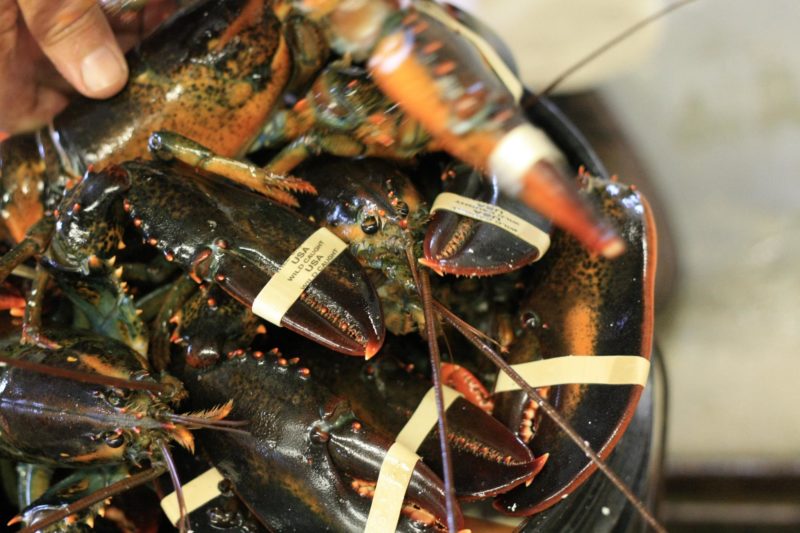Lobsters and sea scallops continued to top Northeast fisheries in value during 2019 – with oysters more modest in volume but rapidly gaining as a growth sector.
On the downside, it looks like tough times for herring will continue into 2020, and there’s no return in sight for Maine’s northern shrimp fishery.
WINNERS
Lobster: Although catch dropped by more than 15 percent this season, the commercial lobster fishery still hauled in 100 million pounds, according to Maine’s Department of Marine Resources. While that marks a 20 million-pound drop from 2018, many still feel positive about the industry’s trajectory over the past decade — after all, the 2019 catch is still above historical averages. Early on, worries about bait availability, right whale protections, trade deals with China, and a potentially larger drop in catch had the industry on edge, for good reason — lobster is worth more than $450 million to Maine’s economy.
“After a very slow start, the harvest numbers increased in the late fall and winter, and from deeper water and farther offshore,” said Steve Train, a lobsterman from Long Island, Maine. “Whether this is a one- or two-year thing because of cold springs and late sheds, or the beginning of a trend where the resource is shifting because of a change in climate, is still to be determined. But one thing appears obvious: The resource is healthy.” Export of lobster to China dipped by 46 percent after a tariff was imposed in 2018, and the coronavirus outbreak further disrupted the trade in lobsters from the U.S. and Canada.
Oysters: The taste for oysters seems to have no end in sight, and 2019 was no exception. The East Coast Shellfish Growers Association Executive Director Bob Rheault said that along the Atlantic coast “farmed oyster production has doubled in the past five years. There has been some consolidation — bigger firms buying smaller ones, and lots of new entrants” with most farms aiming to increase production. Despite half a decade of increased East Coast production, prices have trended up slow and steadily. The association estimates the total East Coast oyster industry is valued at $90 million, although many states lack good data. Rheault says raw bars are hot.
“Our consumer base used to be old men, and now we are seeing millennials and women. Everyone seems to want to eat fresh oysters and Instagram the experience, compare flavors from different areas and really savor oysters like fine wines.”
Atlantic sea scallops: Regulators consider Atlantic sea scallops healthy, not overfished or subject to overfishing. Results from the 2019 Atlantic scallop survey were promising for the largest and most valuable wild scallop fishery in the world. In the 2018-19 season, 62.5 million pounds were landed from federal waters, with New Bedford fleets bringing in much of that. At auction, 10/20 was $9.50-10.50 per pound and U-12s were $14-15.
“While there are fluctuations in the yearly catches overall, the scallop industry has become the strongest fishing industry in our area,” says Mike Johnson, general manager of Fleet Fisheries in New Bedford, Mass. “This is mostly thanks to responsible fishing practices and good scientific evidence through gathering raw data.”
In Maine, where the fishery is dominated by dayboats and some hand harvesters, the state Department of Marine Resources manages the fishery through a system of closures in state waters on a three-year rotating basis and smaller “targeted closures” While the fishery no longer sees peak hauls like it did in the 1990s before the fishery crashed, there is optimism. Maine’s 2018-19 season was valued at almost $6 million, with a total of 563,363 pounds of “meat weight” landed. While landings and prices dropped from the previous season, prices were still around $10.50 per pound.
Seaweed: 2018 marked a record-setting year for seaweed in Maine (22 million pounds). For 2019, numbers are not in yet, but a recent court ruling curtailing the harvest of wild rockweed (worth $1 million dollar at the docks), with landings consistently making up more than 95 percent of all landings statewide, could take a toll. Ongoing shifts to cultivated seaweed continue, and with a value of all farmed seaweed produced in North America under $1 million, there is a push to encourage processors to invest and expand markets to full potential.
LOSERS
Maine shrimp: The Northern shrimp story sounds like a tragic broken record for an industry that used to be worth around $16 million annually.
“The Gulf of Maine is changing rapidly, as is our understanding of that change and its impacts,” says Maggie Hunter, a scientist at Maine’s Department of Marine Resources. “We cannot rely on systems behaving the way they have in the past, which is challenging for scientists and managers.”
With Northern shrimp spawning biomass as well as recruitment at historic lows, the shrimp fishery remained shuttered in 2019, as it had been since 2013. Ocean temperatures in western Gulf of Maine shrimp habitat have increased, reaching unprecedented highs within the past several years. With temperatures predicted to continue rising, things do not bode well for the recovery of this fishery.
Given the low biomass of the stock, the Northern Shrimp Section did not establish a research set-aside for 2019, which in past years allowed for tiny amounts of high-priced shrimp to keep a small corner of the market open.
“Should recruitment improve,” said Dustin Leaning of the Atlantic States Marine Fisheries Commission, “it would take several years for those shrimp to be commercially harvestable.”
Herring: The species that has been an important backbone to Maine’s valuable lobster industry had a rough year. The lobster industry is used to fluctuations and adapting to change, but herring as bait has seen better days. Federal regulators cut quota by more than a half in 2019, from 50,000 metric tons to 21,000 metric tons.
The assessment results were very sobering,” reported Janice Plante, of the New England Fishery Management Council, in the spring. “We learned we had very poor recruitment several years in a row. Overall, biomass was much lower than many expected.” Wyatt Anderson, of O’Hara Lobster Bait in Rockland, Maine, said there was a bit of herring around in 2019, but that menhaden was what saved the day.
“All kinds of pogies came into the coast of Maine. The pogies filled the void. There was some herring around, but we didn’t need ’em.” If you could get herring, it was $250-$275 per barrel, while locally harvested pogies were $80-$125 a barrel (about 400 pounds). “If pogies come in 2020, we’re OK, even though the herring quota is cut so much,” Anderson added.
ONES TO WATCH
Surf clams and ocean quahogs: The 2019 quotas for both species were the same as in 2018. And it appears that landings for both were down from 2018, with both well below quota. Surf clam landings were under 2 million bushels and ocean quahogs under 2.5 million bushels.
Mike Costa, vice president of Nantucket Sound Seafood in New Bedford, Mass., has been in the clam business since 1981. He says shutdowns in traditional grounds caused a 15 to 20 percent drop in both catch and value.
“We’re down about $100,000 from 2018.” Costa says dock prices were $23 per 80-pound bushel, on average, in his area. The effects of future climate change on surf clam and quahog commercial fisheries is being watched, as studies show both have high vulnerability to changes of ocean temperature and acidification.
Groundfish: There were several groundfish-related actions under development in 2019, including setting catch limits for 2020-22 for most stocks and shared U.S/Canada stocks of some species on Georges Bank. The New England Fishery Management Council is looking at whether 100 percent at-sea monitoring can deliver improved data and management, possibly through electronic monitoring.
Scup: Some in the industry think scup is an underappreciated fish. Recently, landings haven’t matched quotas, and there is room for market growth. Average wholesale prices for 2019 were 85 cents per pound for medium, $1.25 for large, and $1.50 for jumbo.







